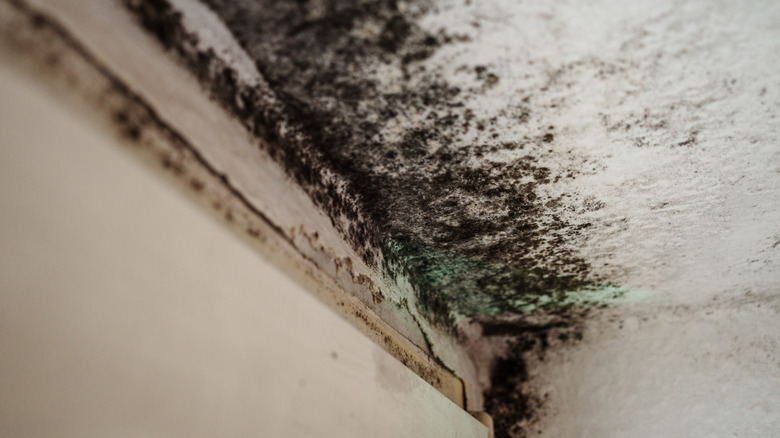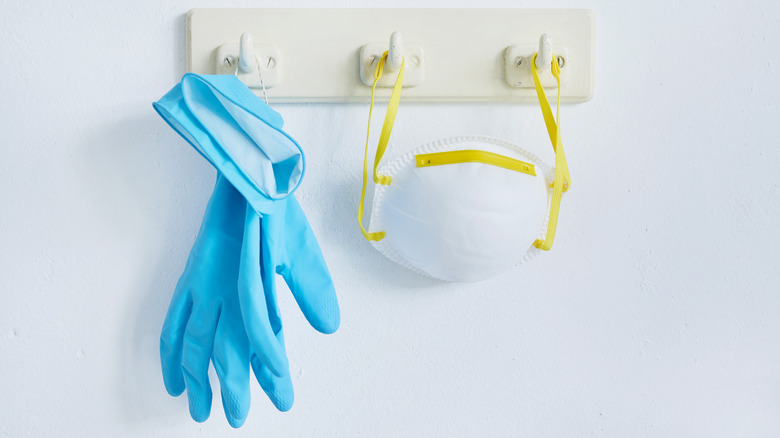How To Remove Black Mold From Your Bathroom Ceiling (& Prevent It From Ever Coming Back)
We may receive a commission on purchases made from links.
Nothing quite kills the vibe of a relaxing hot shower like looking up to find black mold creeping across your bathroom ceiling. It's as gross as it is stubborn, and unfortunately, it's also super common in humid spaces, but don't worry, you can get rid of it. Whether you're dealing with a small patch or a full-blown situation, white vinegar can solve the issue. By using a white vinegar spray and a hard-bristle brush, you can not only remove black mold but also kill it and prevent it from coming back.
Before you get started, it's important to understand what's causing mold to appear on your bathroom ceiling. Oftentimes, the answer is super simple: it's just humidity and heat. The repeated moisture that comes from steamy showers and bath splashes can cause mold to appear. Then, continued heat helps it grow and spread. These prime mold-growing conditions are made worse by poor ventilation, which causes a bathroom to fail to evacuate humidity and stay damp longer. One of the benefits of a bathroom exhaust fan is that it helps steam get out of the bathroom before it causes too much damage.
And this issue is no joke; identifying black mold in your home is bad news for your health. By breathing in mold spores, you and your family might start to suffer from allergies and irritations. These can look like sneezing, coughing, congestion, and even irritated eyes. For people with asthma, this is even more concerning because it can worsen existing conditions.
Safety precautions when removing black mold
Before we get into how to remove and kill black mold, you'll need to get the appropriate equipment. As mentioned, black mold is dangerous, and spores can float into the air and enter your eyes, mouth, and lungs, especially when brushing it off the ceiling. Therefore, you should wear a face mask, gloves, and protective goggles when working on black mold to prevent the spores from affecting your health.
It's best to use an N95 mask or something stronger (like a respirator) because they can filter 95% of particles that float in the air. If you don't have any, get affordable ones like these AccuMed N95 Protective Face Masks, which will come in handy for other home improvement projects that involve painting or sanding. It's also recommended to use sealed goggles to prevent spores from falling into your eyes when scrubbing black mold from the ceiling.
To work on the mold, use a brush with hard bristles and a dry and clean rag. However, once they're contaminated, they'll need to be thrown out, so make sure to use items that you won't need again and that don't cost too much money. And since we're working with ceilings, black mold removal also requires a step ladder that's stable and secure.
Removing black mold with vinegar
Once you have all your supplies, it's time to fight that mold. Pour some undiluted white vinegar into a bottle like this Teyssor Spray Bottle, and apply vinegar directly onto the mold. Let the vinegar sit on the mold for about an hour or more (even overnight) before starting to scrub. That way, the white vinegar will have time to get into the ceiling and penetrate the layers to kill the mold and stop it from growing. The reason vinegar can do this is that it is so acidic, which makes it antibacterial and antifungal.
After letting the vinegar work its magic for an hour or more, a bit of elbow grease and effort is still required to make the mold truly go away. Grab your brush and start working on the stains on your ceiling until the black spores come off. Once your ceiling is back to its original color, use the dry rag to dry the area and remove leftover moisture from the vinegar. Do not apply water or anything else to remove the vinegar from the ceiling, as that would be counterproductive and reintroduce moisture to the area.
Other methods are commonly used to remove and kill mold, including bleach and hydrogen peroxide. However, neither of these methods is effective on porous materials like drywall, which is often used for ceilings. Instead, both can effectively kill mold on flat surfaces like tile, so feel free to use them in showers, bathtubs, or tiled walls.
Preventing mold from coming back
To prevent mold from coming back, consider leaving the spray bottle of vinegar in your bathroom and using it regularly as a preventative method. Just a few sprays of vinegar on the ceiling after a steamy shower can go a long way to prevent mold from growing back.
Other simple and important ways to prevent heat and moisture from being trapped in your bathroom include opening up a window after every shower to aerate the room. Of course, you might not have a window in your bathroom, which makes the tasks a bit more complicated. Instead, focus on your exhaust fan. If you have one but find that moisture is still getting trapped in the bathroom, this might also be a good reminder to clean your bathroom fan to help with airflow. If your exhaust fan is not working, consider black mold your sign to get it fixed. These fans suck air out of the bathroom and push it outdoors, and they're required in all bathrooms in the United States under the National Electrical Code. To see if your bathroom fan is working as it should, scratch a match, blow it off, and place it near the exhaust vent. If all works well, you should see the smoke from the match being sucked into the fan.
If the mold problem persists despite increased ventilation, consider hiring professionals to help you reduce the spread. They might be able to identify more serious problems, like a leak in the ceiling, that are causing the mold to come back.



